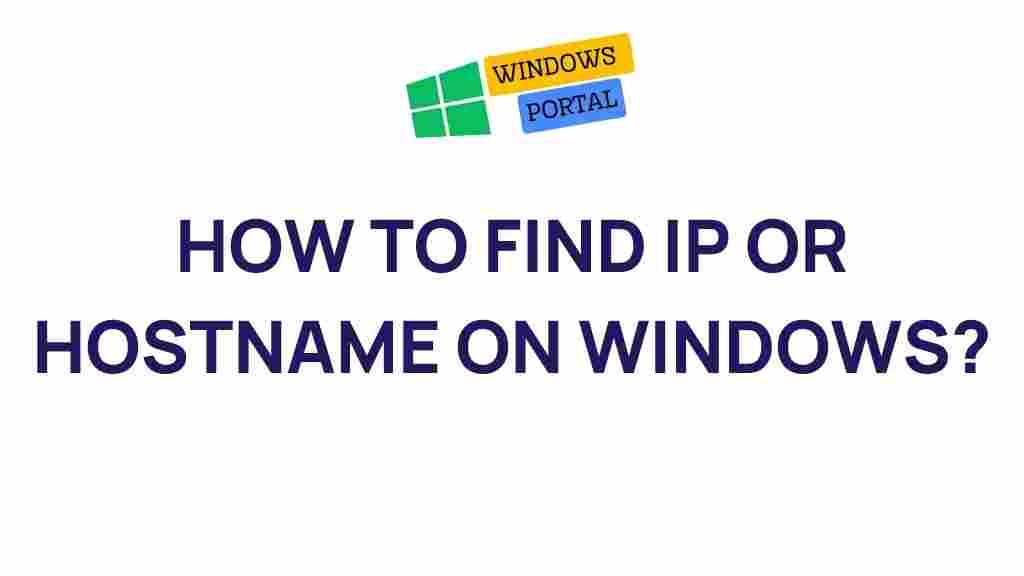Unveiling the Secrets of Locating IP or Hostnames on Windows
In today’s digital world, understanding how to locate an IP address or hostname on Windows is essential for troubleshooting network issues, ensuring security, and managing devices. Whether you’re a casual user or a seasoned IT professional, this guide will walk you through the various methods to uncover these important details, helping you harness the power of your network.
What is an IP Address?
An IP (Internet Protocol) address is a unique identifier assigned to each device connected to a network. It serves two main functions: identifying the host or network interface and providing the location of the device in the network. Understanding IP addresses is crucial for:
- Network Management: Helps in managing devices within a network.
- Troubleshooting: Aids in diagnosing connectivity issues.
- Security: Helps identify unauthorized devices in the network.
How to Locate IP Addresses on Windows
Locating your IP address or hostname on Windows can be accomplished in several ways. Here are the most effective methods:
Method 1: Using Command Prompt
The Command Prompt is a powerful tool that can provide you with all the necessary information regarding your network configuration. Here’s how to use it:
- Press Windows + R to open the Run dialog box.
- Type cmd and hit Enter to open the Command Prompt.
- In the Command Prompt window, type ipconfig and press Enter.
The output will display your IP address, subnet mask, and default gateway. Look for the section labeled IPv4 Address for your current IP.
Method 2: Using Windows Settings
You can also find your IP address through the Windows Settings app. Here’s how:
- Click on the Start menu and select Settings.
- Navigate to Network & Internet.
- Select Status from the left sidebar.
- Click on Properties under the network you are connected to.
Your IP address will be listed under the IP assignment section.
Method 3: Using Network Connections
Another way to find your IP address is through the Network Connections settings:
- Right-click on the Network icon in the system tray and select Open Network & Internet settings.
- Click on Change adapter options.
- Right-click on your active network connection and select Status.
- Click on Details to view your IP address information.
Method 4: Using PowerShell
PowerShell is another powerful command-line tool available in Windows. To locate your IP address using PowerShell:
- Press Windows + X and select Windows PowerShell.
- Type Get-NetIPAddress and press Enter.
This command will display all IP addresses assigned to your device, along with additional details.
Finding Hostnames on Windows
Locating a hostname on Windows is just as important as finding an IP address. Here are methods to achieve that:
Method 1: Using Command Prompt
You can also use the Command Prompt to find your hostname:
- Open the Command Prompt as described earlier.
- Type hostname and press Enter.
Your device’s hostname will be displayed immediately.
Method 2: Using Windows Settings
To find your hostname through Windows Settings:
- Open the Settings menu.
- Select System.
- Click on About.
- Your hostname will be displayed under the Device name section.
Method 3: Using System Properties
Here’s how to find your hostname via the System Properties:
- Right-click on This PC or My Computer on the desktop and select Properties.
- Your hostname will be displayed in the Computer name, domain, and workgroup settings section.
Troubleshooting IP and Hostname Issues
If you encounter issues while trying to locate your IP address or hostname, consider the following troubleshooting tips:
Check Network Connection
Ensure that your device is connected to a network. If you are using Wi-Fi, verify that you are connected to the correct network.
Restart Your Router
Sometimes, restarting your router can resolve connectivity issues, allowing you to retrieve your IP address more reliably.
Flush DNS Cache
Flushing your DNS cache can resolve issues related to hostname resolution. To do this:
- Open Command Prompt.
- Type ipconfig /flushdns and hit Enter.
This command clears the DNS cache and may help resolve any hostname issues.
Disable VPN or Proxy
If you are using a VPN or proxy, it may interfere with your ability to view your IP address. Disable these services temporarily and check again.
Use Third-Party Tools
If you are still having trouble, consider using third-party tools to help identify your IP address and hostname. Many applications are available for download that can assist in network management.
Conclusion
Locating an IP address or hostname on Windows is a straightforward process, thanks to the various methods available through the operating system. Whether you prefer using the Command Prompt, Windows Settings, or PowerShell, understanding how to find this information is crucial for effective network management.
By following the steps outlined in this guide, you can easily uncover the secrets of your network, troubleshoot connectivity issues, and maintain a secure environment. For more tips on networking and technology, check out our blog.
If you have further questions or need assistance, don’t hesitate to consult external resources such as Microsoft’s support page for additional guidance.
This article is in the category Guides & Tutorials and created by Windows Portal Team
